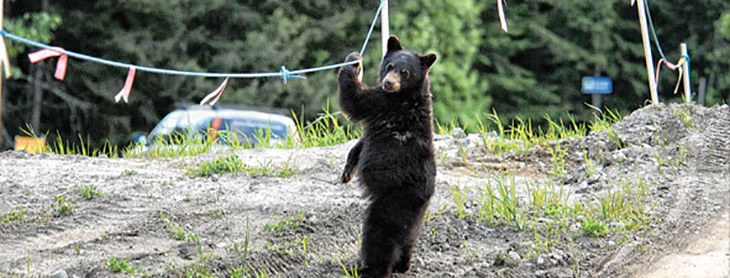
Understanding bear behaviour is an essential part of creating safe environments for both bears and people. More often than not, bear behaviour is misinterpreted. People all too often interpret what a bear does in terms of their own fear. To truly understand bear behaviour, you must interpret bear postures and vocalizations in terms of what the bear fears.
Bear behaviour can be predictable. The more you can learn about bears and how they behave, the less likely you will be to have a negative encounter or misinterpret interactions.
Bears are predictable. In fact, bears are usually more predictable than people. If you learn more about bears and how to interpret their behaviour, you will be able to react appropriately when you see them and avoid a negative encounter.
Bears are NOT ferocious. They are NOT mean or malicious. Bears are normally shy, retiring animals that have very little desire to interact with humans. Unless they are forced to be around humans to be near a food source, they usually choose to avoid us.
Bears, like humans and other animals, have a “critical space” – an area around them that they may defend. Once you have entered a bear’s critical space, you have forced the bear to act – either to run away or be aggressive. The size of the critical space is different for every bear and every situation.
Although black bears and grizzly bears do share some common traits, it’s important to understand the difference in the way they react to perceived threats. Each species has evolved different strategies for survival. Black bears, for instance, are usually less aggressive and more tolerant of people. They often live near human settlements, whereas grizzly bears prefer to stay away from human settlements and are often extirpated from heavily used or populated areas.
Black bears are excellent climbers. When a black bear is threatened he usually runs from the perceived threat or goes up a tree. With cubs out of danger, female black bears don’t have to make vigorous defences that risk potential injury. Although black bears tend to retreat from people, they are still incredibly strong animals that can cause injuries.
Today, brown (or grizzly) bears tend to live in coastal or mountain forests, but they evolved in treeless habitat that influenced their behavioural response to perceived threats. For instance, they are more likely than black bears to defend themselves when threatened. A black bear’s first line of defence is retreat, but grizzlies, especially sows with cubs, can be very aggressive towards other bears and people they perceive as threats.
Grizzlies are not good tree climbers, though it’s important to note that they can climb trees. For instance, a mother grizzly will usually aggressively defend her cubs on the ground rather then send them up a tree as a black bear sow will.
Bears are very curious and will inspect odours, noises and objects to determine if they are edible or playable. Standing up on its hind legs allows a bear to get more information from its senses of smell, sight and hearing. It is a sign of curiosity, not aggression.
Bears are usually active from dawn to dusk, but they may be seen any time of day or night. Bears in many places of high human use have become nocturnal in order to avoid people. While others have become habituated to people in order to gain access to their plentiful buffet of improperly stored garbage and other attractants.
Bears can be very social. Bears are often described as asocial when compared to wolves, chimps or lions, but to use the term “asocial” to describe bears is incorrect. While bears do not live in extended family groups or join in hunts, they can co-exist in very close proximity to each other and in fact form alliances and friendships – some adult bears have even been known to mentor younger unrelated bears; young unrelated subadults hang around in pairs and even groups (likely because there is strength in numbers). The bears of a region are usually familiar with one another and meetings consist of complex social exchanges. Some bears like each other and other simply don’t tolerate one another in their respective home ranges – not unlike people’s relationships with each other.
Bears are not territorial. Being territorial means keeping other members of your species away from a given area. Wolves and primates are territorial – bears are not. Bears, like people, share home ranges. This mutual use of land and resources is a basis for bear social behaviour.
Bears habituate, or become accustomed, to people just like they do other bears. Because plentiful food resources can be localized – salmon in a stream or berries on a mountainside – bears have evolved behaviour that allows them to tolerate each other at close distances. This behaviour is transferred to their relationship with humans. If they are not shot or harassed, bears habituate to people the same way they do to each other.
Bears live in a dominance hierarchy based on age, size and temperament. Mature males are at the top of the hierarchy, and sub-adults and cubs at the bottom. Bears establish and maintain their social position and place in the hierarchy by posturing or acting aggressively. Single females and subadults are almost always submissive to mature males but have a loose hierarchy within their own group.
Bears react to new things in their environment. New objects or situations often frighten bears. Behaviourists call this “strange object response.” After an initial fright, bears will often investigate what alarmed them. This is not an aggressive act and shouldn’t be regarded as one.
Bears are not always aware. Bears, particularly adult brown bears, are not always aware of what is going on around them. A bear following a trail doesn’t always look ahead. He may be distracted by a yummy food source or may not be able to hear over the loud sounds of rushing water or blowing wind. A bear can literally blunder into an unsuspecting person.
(c) Living in Harmony with Bears by Derek Stonorov, published by National Audubon Society, 2000
